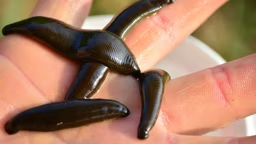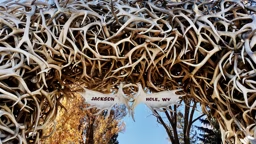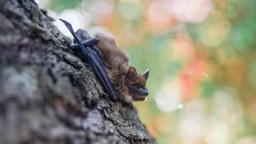
Author Rob Mies displaying the biggest bat in the world; it has a 6-foot wingspan. The Malayan flying fox is a fruit bat found in southeast Asia.
For owners of cabins, cottages and camps, living in nature is a wonderful experience. It can also be an annoying adventure – from the biting insects to the squirrels that chew on your cabin to the deer that eat the plants in your garden. The trick is to find a way to live in harmony with the animals that also call your property home. After reading this article, you may want to teach your friends and family about protecting bats, put up a bat house and plant a native flower garden for bats and other wildlife.
Bat Fast Facts
- Bats, with 1,300 different species worldwide, are the only flying mammals.
- About 50 species of bats live in the United States and Canada.
- Most bats eat insects – up to 5,000 each night!
- Female bats have one or two babies each year.
- Bats can live 20 to 40 years, although they don’t show signs of age.
- Bats use high-pitch sounds (echolocation) to navigate the darkness.

Photo: Clement Falize / Unsplash
Why Bats Are Important
Bats are one of the most unique and important animals on the planet. They are the only mammals in the world that can fly, and they provide amazing ecological and economic benefits to humans. Most bats in North America eat bugs. As a matter of fact, bats are the primary predators of nighttime insects. One bat can eat thousands of insects each night. Many of these bugs include crop-damaging insects that destroy food. Other bats around the world pollinate plants like agave, bananas, and avocados and spread fruit seeds like mangos, dates and figs.
Misconceptions About Bats
Unfortunately, many people fear bats and purposely or inadvertently hurt bats. Bats naturally live in dead trees and rock crevices during the summer, where they raise their babies safe from predators. But when natural places are not available, many bats try to live in human buildings. That’s when people hurt bats to get rid of them. Bat houses give bats a safe place to raise their babies and sleep during the day.
Bats also need healthy places to find food. Since most bats in North America eat insects or drink nectar, planting wildflower gardens will provide them much-needed feeding places. Moths and other insects are attracted to the gardens at night, giving the insect-eating bats healthy meals. Make sure to garden without pesticides so the bats are safe from consuming chemicals.

Photo: Geoff Brooks / Unsplash
White Nose Syndrome
An invasive fungus from Europe arrived in the US in 2006. This cold-loving fungus thrives in cold, humid climates of caves and mines. Many bats seek refuge from cold winters and the reduction of insects. While hibernating in white-nose-syndrome-infected sites, bats wake to fight off the invasive fungus growing on their skin and changing their metabolism, causing them to burn fat they'd need to survive winter. After waking too many times during the winter, the affected bats fly out on the landscape in search of food, most often only finding snow and cold. And they perish due to starvation.
Over the past decade, the deadly fungus has spread to 37 states and seven provinces, and has claimed the lives of nearly 1 million bats each year. Scientists have discovered successful laboratory treatments to assist bats in fighting off the fungal infection. These treatments are currently being tested in limited caves and mines to determine if they can be applied on a large scale.
If we don’t stop the spread of this fungus soon, it will be the biggest wildlife catastrophe in North America in the last century.

Photo: Jeremy Zero / Unsplash
How to Help Protect Bats
Teaching your friends and family about bats is easy! Most people think bats are blind, will get caught in their hair, will drink their blood, and carry many diseases. Bats aren’t blind; they don’t like our hair; vampire bats only live in Central and South America; and very few bats get diseases. In reality, bats are incredibly important animals that consume large numbers of insects, pollinate important crops, and help plant delicious fruit trees. And they do this for free!
Join millions of people across the continent working together to teach Americans about the importance of bats, the threats of extinction, and how we can work together to save bats. It’s easy for anyone to replace missing natural bat roosts with bat houses, plant wildflower gardens to feed bats, and reduce spraying deadly chemicals.
We can’t let bats disappear. They are way too important. They are way too cool. They need us to help save them.
More ideas to help preserve bats in your environment:
- Plant a native flower garden for wildlife (including bats).
- Use pesticide-free methods of gardening.
- Plant shagbark hickory trees – bats love to sleep under the peeling bark.
- Teach friends and neighbors that bats are beneficial and in need of saving.
- Put up a bat house (or two or three) at your home and cabin.
About the Author
Rob Mies is a bat scientist, author and conservation spokesperson. He has appeared on many national television shows including the recent Discovery Channel series Trailblazers where he explored the caves and forests of Papua New Guinea.










